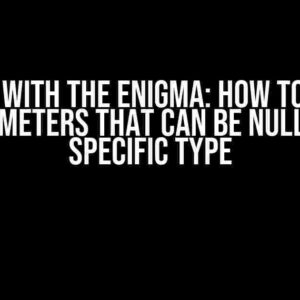Are you tired of dealing with complex data transformations in your workflows? Do you struggle to match key arrays with value arrays using Jolt Transformer? Look no further! In this comprehensive guide, we’ll take you through the process of using Jolt Transformer to match key arrays with value arrays, step by step.
What is Jolt Transformer?
Jolt Transformer is a powerful open-source data transformation tool that allows you to manipulate JSON data with ease. It provides a simple and intuitive way to transform and map data from one format to another. With Jolt Transformer, you can perform various data transformations, including matching key arrays with value arrays.
Why Match Key Arrays with Value Arrays?
In many real-world scenarios, you may encounter situations where you need to match key arrays with value arrays. For instance, suppose you have a list of users with their corresponding preferences, and you want to transform this data into a format that’s easier to work with. In this case, you would need to match the key array (user IDs) with the value array (preferences).
This type of data transformation can be challenging, especially when dealing with large datasets. But with Jolt Transformer, you can achieve this with ease.
Step 1: Prepare Your Data
Before you start using Jolt Transformer, ensure that your data is in a format that can be easily transformed. For this example, let’s assume you have the following JSON data:
[
{
"id": 1,
"name": "John Doe",
"preferences": ["reading", "hiking", "cooking"]
},
{
"id": 2,
"name": "Jane Doe",
"preferences": ["swimming", "dancing", "singing"]
},
{
"id": 3,
"name": "Bob Smith",
"preferences": ["coding", "gaming", "writing"]
}
]
Step 2: Define Your Jolt Specification
In Jolt Transformer, you define a specification that outlines the transformation you want to apply to your data. In this case, you want to match the key array (user IDs) with the value array (preferences). Here’s an example Jolt specification:
[
{
"operation": "shift",
"spec": {
"*": {
"id": "ids.&",
"preferences": "prefs.&"
}
}
}
]
In this specification, we’re using the `shift` operation to transform the data. The `spec` section defines the transformation rules. In this case, we’re extracting the `id` and `preferences` values from each JSON object and assigning them to new arrays called `ids` and `prefs`, respectively.
Step 3: Apply the Jolt Specification
Now that you have your Jolt specification, it’s time to apply it to your data. You can do this using the Jolt Transformer command-line tool or by integrating it into your application code.
Here’s an example of how to apply the Jolt specification using the command-line tool:
jolt transform -i input.json -o output.json myspec.json
In this command, `input.json` is the input data file, `output.json` is the output file, and `myspec.json` is the Jolt specification file.
Step 4: Verify the Results
After applying the Jolt specification, you should see the transformed data in the output file. Here’s what the output should look like:
{
"ids": [1, 2, 3],
"prefs": [
["reading", "hiking", "cooking"],
["swimming", "dancing", "singing"],
["coding", "gaming", "writing"]
]
}
As you can see, the Jolt Transformer has successfully matched the key array (user IDs) with the value array (preferences).
Advanced Techniques
In this section, we’ll cover some advanced techniques for matching key arrays with value arrays using Jolt Transformer.
Using Conditionals
Sometimes, you may want to apply different transformations based on certain conditions. Jolt Transformer allows you to use conditionals to achieve this.
[
{
"operation": "shift",
"spec": {
"*": {
"id": {
"=( @ == 2)": "idsAdmin",
"*": "ids.&"
},
"preferences": "prefs.&"
}
}
}
]
In this example, we’re using a conditional statement to check if the `id` value is equal to 2. If it is, we assign the value to the `idsAdmin` array. Otherwise, we assign it to the `ids` array.
Using Functions
Jolt Transformer provides a range of built-in functions that you can use to perform complex data transformations. For example, you can use the `concat` function to concatenate multiple arrays:
[
{
"operation": "shift",
"spec": {
"*": {
"id": "ids.&",
"preferences": "prefs.&",
"allPrefs": "=concat(prefs.*)&"
}
}
}
]
In this example, we’re using the `concat` function to concatenate all the `prefs` arrays into a single array called `allPrefs`.
Best Practices
When using Jolt Transformer to match key arrays with value arrays, here are some best practices to keep in mind:
- Use clear and concise variable names to avoid confusion.
- Test your Jolt specification thoroughly to ensure it produces the desired output.
- Use conditionals and functions judiciously to avoid complexity.
- Document your Jolt specification for future reference.
Conclusion
Matching key arrays with value arrays using Jolt Transformer is a powerful technique that can simplify complex data transformations. By following the steps outlined in this guide, you can use Jolt Transformer to transform your data with ease. Remember to follow best practices and test your specification thoroughly to ensure accurate results.
| Key Array | Value Array |
|---|---|
| User IDs | Preferences |
With Jolt Transformer, you can take your data transformation skills to the next level. So why wait? Start transforming your data today!
- Download Jolt Transformer from the official website.
- Read the official documentation to learn more about Jolt Transformer.
- Join the Jolt Transformer community to connect with other users.
Happy transforming!
Frequently Asked Question
Get ready to supercharge your data transformation with Jolt Transformer! Here are some frequently asked questions about matching key arrays with value arrays.
Q: What is Jolt Transformer, and how does it help with data transformation?
Jolt Transformer is a JSON to JSON transformation library that helps you manipulate and transform your data with ease. It’s perfect for matching key arrays with value arrays, and it’s incredibly flexible and customizable.
Q: How do I use Jolt Transformer to match key arrays with value arrays?
To match key arrays with value arrays using Jolt Transformer, you’ll need to define a specification that outlines the transformation. This specification is written in JSON and consists of an array of operations that Jolt will apply to your data. Don’t worry, it’s easier than it sounds!
Q: What kind of operations can I perform with Jolt Transformer?
With Jolt Transformer, you can perform a wide range of operations, including shifting, defaulting, sorting, and more. You can also use conditional logic and recursion to make your transformations even more powerful.
Q: Is Jolt Transformer difficult to learn and use?
Not at all! Jolt Transformer has a gentle learning curve, and the community is very active and helpful. Plus, there are tons of examples and tutorials available online to get you started.
Q: Can I use Jolt Transformer for other data transformation tasks beyond matching key arrays with value arrays?
Absolutely! Jolt Transformer is an incredibly versatile tool that can handle a wide range of data transformation tasks. Whether you need to flatten data, convert data types, or perform complex aggregations, Jolt Transformer has got you covered.




